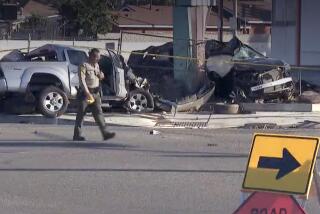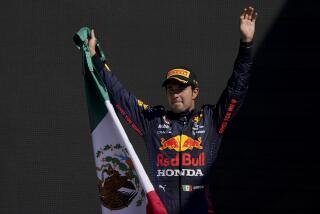UP TO SPEED AGAIN : Four Months After Coma, Guerrero Ready to Race
- Share via
CHANDLER, Ariz. — At first glance, it looked like any other tire test at Firebird International Raceway.
The red No. 4 March race car was rolled out of the 18-wheel transporter that had “Vince Granatelli Racing” painted on its sides, the red-uniformed driver pulled his fire-retarding helmet liner over his head, buckled his black-and-white striped helmet and climbed into the car.
Mechanics hovered, kneeling alongside the driver, adjusting his seat belts and checking the helmet radio.
Testing was due to start at 9 a.m., but eagerness was in the air. It was 8:55 on a clear, crisp Thursday a few miles south of Phoenix when the engine was fired up.
Photographers pressed in around the car, their cameras poised to catch every reaction from the man in the cockpit, from the crew, from a knot of onlookers.
It was apparent that this was no ordinary test.
Roberto Guerrero was in the car--four months and four days from the time he smacked the wall at the Indianapolis Motor Speedway, an accident that left him in a coma for two weeks. This was a test not of tires or chassis suspension, this was a test of a man.
How would Guerrero, one of the brightest young talents in racing, react his first time back in a race car after an accident that many feared might leave him impaired for life?
After three laps around the 1.1-mile, eight-turn Firebird road circuit, Guerrero brought the car back to the pits.
“It was great, just great,” he said, first in English and then in Spanish. “It feels like I was never out of the car. I feel 100%. I was nervous the first couple of laps, but then I started relaxing.”
With that said, and a few whispered comments to car owner Granatelli and crew chief Larry Curry, the 29-year-old Colombian got back into the car and began to work up to serious speeds.
The big clock at the end of the Firebird drag strip displayed his speeds through the timing trap. They moved steadily up: 121.47, 137.11, 147.54 and finally 150.25. Then he clocked a series of laps during which the board kept repeating 150 and fractions.
“Look at the consistency, right off the bat,” enthused Granatelli. “He’s doing exactly what I expected he would do. It’s like he was never away.”
Track proprietor Charlie Allen, who ran the Orange County Raceway drag strip before it was razed, pointed out that Guerrero was running even faster than the speeds displayed.
“He’s still accelerating when he goes through the lights, so his top speeds are probably 15 m.p.h. faster before he starts braking for the turn,” Allen said.
The next time Guerrero pitted, after about a dozen more laps, the smile that spread across his face was the kind you’d expect if he had just won the Indianapolis 500.
“It feels so nice to be back,” he said. “I was very nervous--more nervous than I have ever been--before this morning. I had always felt I would be OK, but until I actually did it, there were doubts in my mind. Now it feels completely normal to me, like I was coming back after a vacation.”
Last Sept. 11, as Guerrero was preparing to come in after his second day of tire testing at Indianapolis, something let go in the car’s left rear suspension, sending the vehicle spinning into the Turn 2 wall at about 180 m.p.h. The impact knocked off the right front wheel, which flew up and hit Guerrero in the helmet.
He lay in a coma for two weeks at Methodist Hospital in Indianapolis before he was able to even recognize his wife, Katie, or his 2-year-old son, Marco. It wasn’t until the first of December that he was well enough that he and his family could return to their home in San Juan Capistrano.
A week before his accident, Guerrero had won his second Indy car race, at Mid-Ohio.
“The last time I can remember being in a race car before today was the Mid-Ohio race,” he said. “It’s funny, I can remember being at the (Indianapolis) Speedway and talking to some people there, but I can’t remember a thing about driving those two days before the accident.
“I had some apprehension, a lot, in fact, about how I would react in the race car today, but I have no concern about the accident. Except for the time lost, it’s as if it never happened. I remember nothing, and from what I’ve been told, it was such a freak thing that it is not likely to ever happen again.
“If the tire had not hit me in the head, I would have walked away without a scratch. The doctors said there wasn’t a mark on me. I never even had a headache. I have no bad feelings about the accident.”
Guerrero said he had never given a thought to giving up racing during his convalescence.
“It is my life, it’s what I love doing, it’s what I’ve always wanted to do,” he said. “I would be a very unhappy person if I couldn’t race.”
Thursday’s test, designed specifically to reorient Guerrero with the sensation of driving at speed, was made in a year-old March that the team does not plan to race this season.
“At this point, the thing I need most is miles,” Guerrero said after running off and on until 3:30 p.m. In all, he drove 97 miles and might have had more, but a blown turbocharger gasket caused a two-hour delay.
A new Lola is due to be delivered from England Monday in Los Angeles, and Guerrero will begin testing it here at Firebird Jan. 27.
“We’re going ahead with the idea of running the full Indy car CART season, starting with Phoenix,” Granatelli said. The CART season will open Sunday, April 10, with the Checker 200 at Phoenix International Raceway--a race Guerrero won last year by coming from last place for his first Indy car victory.
The Phoenix race was to have been Guerrero’s post-accident debut, but his showing here Thursday earned him an earlier starting date. He was asked to join the field for the first race in the International Race of Champions series Feb. 12 at Daytona International Speedway.
Indianapolis, where the accident occurred, is the third race on the CART schedule.
“Going back there will be the same as it has been before,” Guerrero said. “Like I said, I don’t remember anything about what happened, so there are no bad thoughts.”
If there were bad thoughts, they would probably be about what happened in last year’s race. When Mario Andretti dropped out with 18 laps remaining, Guerrero had a lead of better than a lap but his car stalled during his final pit stop. Before it could be restarted, Al Unser had taken the lead and went on to win his fourth 500.
Guerrero finished second, just as he had in 1984 when he was named rookie of the year. In 1985 he was third, and in 1986 he was fourth. It is one of the most consistent records in Indy history.
With his second at Indy, plus wins at Phoenix and Mid-Ohio, Guerrero still finished fourth in Indy car points despite missing the last three races.
He is still undergoing mental therapy under the direction of Dr. Odie Bracey of the Neuroscience Center of Indianapolis.
“He gave me a complete OK to race, but I’m still doing a few little things with the computer that help my reflexes, my reactions and my memory,” Guerrero said. “I had a little fogging in my mind, but that’s completely cleared.
“Physically, I’m as fit as ever. I’m back to my normal physical workouts, about an hour and a half in the morning with weight training for my upper body, and a little tennis and golf.”
Although Katie and Marco travel with Roberto to all his races, and Katie maintained a round-the-clock vigil when he was hospitalized, they passed up Thursday’s test.
“There’s not much for her and Marco to do during a test, so Katie stayed home today, but she told me to call her all day and let her know what was happening,” Guerrero said. “She has been with me all the way in getting me back into the race car.”
During her husband’s recovery, Mrs. Guerrero was asked if the accident had prompted her to suggest he give up the sport.
“It’s something that never even crossed my mind,” she said. “It’s something that makes him so happy. I wouldn’t think of asking him to quit.”
Granatelli, who recently moved his racing operation from Indianapolis to Phoenix, was nearly as elated as his driver at the day’s testing.
“He’s back, all the way back, in one day,” Granatelli said excitedly. “We’ve been using the same tires all day, and this track chews up tires, but he’s lapping close to what he was doing last year with new tires every 15 laps. I always had faith in his ability to come back, but this is unbelievable, to run as fast and as consistently as he’s doing after four months off.”
Guerrero stood quietly to one side, smiling. It was the smile of a man who had just won the biggest challenge of his life.
More to Read
Go beyond the scoreboard
Get the latest on L.A.'s teams in the daily Sports Report newsletter.
You may occasionally receive promotional content from the Los Angeles Times.










